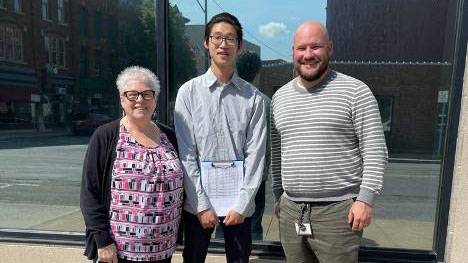Max Wang '22 is one of 26 student fellows conducting research with a community-based organization in upstate New York this summer as a part of the Upstate Institute Summer Field School.
Street parking and parking lot utilization studies are crucial for urban planning as they impact multiple essential aspects of the social-economic activities of the focused area. Occupancy rate indicates whether a parking area is under-utilized or always crowded; peak-trough hours and day-to-day variation information act as a helpful resource for both drivers and local business owners to adjust their visit/operation plans. Collectively, this data helps city officials improve urban planning practices, which translates to an improvement in citizens’ overall living experience.
It has been almost 10 years since there was a parking lot study conducted in the City of Oneida, Madison County. This summer, the Oneida City Planning and Development Department wanted a new parking inventory research project done that would collect data about city-owned parking lots and street parking occupancy within the Downtown Commercial Zoning District. This project is spurred by the City of Oneida’s recent success in being awarded a New York State Grant in the fifth round (2021) of the Downtown Revitalization Initiative (DRI). The City of Oneida will receive $10 million through the grant, intended to help communities boost their post-COVID economies by transforming downtowns into vibrant neighborhoods. The parking study will inform the Planning Department about current parking occupancy and will guide decisions such as whether to expand their inventory by creating new parking lots to compensate for new business initiated through the DRI investment. Additionally, the data will help city officials address complaints from citizens about a lack of parking.
I have never participated in the Upstate Institute Summer Field School during my four years at Colgate as I was focusing on the academic side of research with faculty. Through the geography department, I heard about this research position and reckoned it as a great opportunity to apply GIS knowledge and map-making skills that I have learned in class to solve real-world problems by using spatial analytic technologies to visualize abstract numeric data. Moreover, it could be a great way to familiarize myself with the economics and governance of local communities and make contributions based on my ability.
My field research with the City of Oneida involves 1. counting all the street parking and city-owned parking lot spots in the downtown area and labeling them, 2. surveying the parking spots every hour and keeping track of the plate number of the cars occupying each spot, 3. plotting the hourly occupancy number data in excel to know the peak hours, and 4. mapping the downtown area parking occupancy by color-labeling parking areas using ArcGIS Pro.
For the first half of the project, my duty was to take surveys along the streets every hour and transport the raw data into Excel sheets for temporal analysis; the second half consisted of calculating the average occupancy rate for a given time of the day across the weekdays. Then, occupancy data will be joined to polygons created in ArcGIS Pro, indicating parking areas, and color-coded. The final product of the research will include a report of occupancy summary of the studied areas, as well as multiple maps visualizing the parking area usage, which would be helpful for the planning department as well as for citizens to get familiar with parking available in the downtown area.
